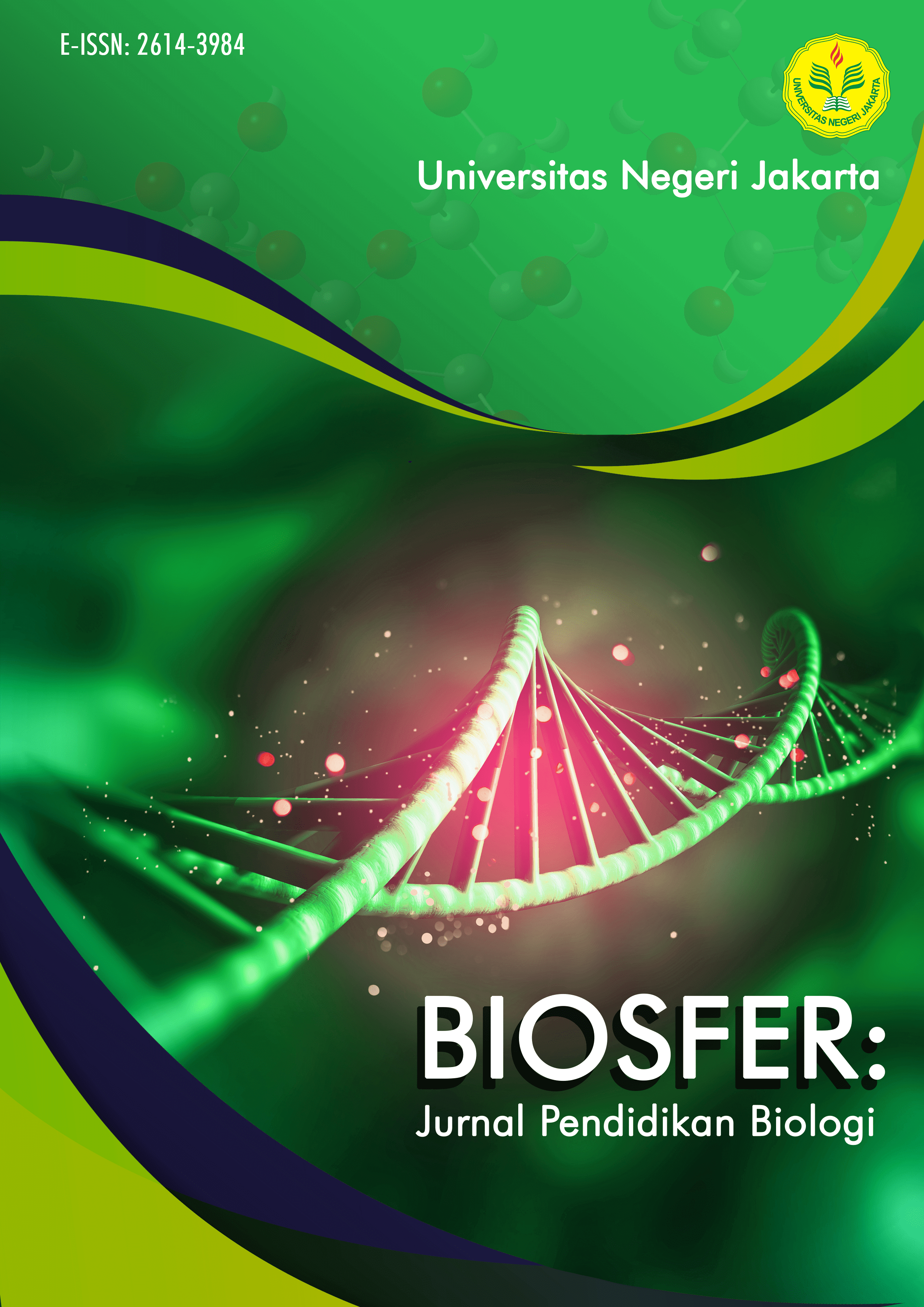Analysis of high school student’s mental model on fungi: Representation of students' conceptions
DOI:
https://doi.org/10.21009/biosferjpb.28195Keywords:
Concept Map, Fungi, Drawing-writing Test, Interview, Mental ModelAbstract
Learning biology requires complete knowledge in understanding it, as well as in fungi. Lack of understanding of a concept, difficulty in finding relationships between concepts, and lack of teachers’ understanding are the main causes of misconceptions which can be represented through mental models. This study aims to analyze students' mental models of fungi through drawing and writing tests (DW), concept maps, interviews, and questionnaires. Using descriptive analysis, researchers use qualitative analysis and interpretation to support the quantitative results. A total of 30 students of grade 10 were given a test. The results showed that the level of students' mental models on the fungi structure was at the level of D3 W3 (46.43%) or wrong/irrelevant answers and fungi reproductive was the level of D3 W2 (17.85%) or partially correct drawing and irrelevant writing. On concept maps, as many as 60.71% of students were at emergent level and the other students were at the transitional level. Most of the answers in the interviews showed agreement with the results shown in the quantitative tests, while the questionnaires indicated the learning experiences and difficulties that students encountered in learning the functions. The conclusion of this study shows that the mental model of students on fungi is still not close to the mental model of experts.
References
Byrne, J. (2011). Models of micro-organisms: Children’s knowledge and understanding of micro-organisms from 7 to 14 years old. International Journal of Science Education, 33(14), 1927–1961. https://doi.org/10.1080/09500693.2010.536999
Cakir, M., & Crawford, B. (2001). Prospective Biology Teachers’ Understanding of Genetics Concepts.
Drach-Zahavy, A., Broyer, C., & Dagan, E. (2017). Similarity and accuracy of mental models formed during nursing handovers: A concept mapping approach. International Journal of Nursing Studies, 74(January), 24–33. https://doi.org/10.1016/j.ijnurstu.2017.05.009
Gunes, F. (2022). Understanding and Mental Model Development. The Journal of Limitless Education and Research, 7(2), 180–215. https://doi.org/10.29250/sead.1101064
Hamdiyati, Y., Sudargo, F., Fitriani, A., & Rachmatullah, A. (2018). Changes in prospective biology teachers’ mental model of virus through drawing-writing test: An application of mental model-based microbiology course. Jurnal Pendidikan IPA Indonesia, 7(3), 302–311. https://doi.org/10.15294/jpii.v7i3.14280
Hamdiyati, Y., Sudargo, F., Redjeki, S., & Fitriani, A. (2018). Using concept maps to describe undergraduate students’ mental model in microbiology course. Journal of Physics: Conference Series, 1013(1). https://doi.org/10.1088/1742-6596/1013/1/012014
Hamdiyati, Y., Sudargo, F., Redjeki, S., & Fitriani, A. (2017). Biology Students’ Initial Mental Model about Microorganism. Journal of Physics: Conference Series, 812(012027). https://doi.org/10.1088/1742-6596/812/1/012027
Hamdiyati, Y., Sudargo, F., Redjeki, S., & Fitriani, A. (2018). Changing of Student’S Mental Model About Virus Through Microbiology Course Program Based on Mental Model. Edusains, 10(1), 74–82. https://doi.org/10.15408/es.v10i1.7777
Hasruddin, & Putri, S. E. (2014). Analysis of Students’ Learning Difficulties in Fungi Subject Matter Grade X Science of Senior High School Medan Academic Year 2013 / 2014. International Juornal of Education and Research, 2(8), 269–276. http://digilib.unimed.ac.id/id/eprint/21887
Jalmo, T., & Suwandi, T. (2018). Biology Education Students ’ Mental Models on Genetic Concepts. Journal of Baltic Science Education, 17. http://www.scientiasocialis.lt/jbse/?q=node/675
Jansoon, N., R.K, C., & E, S. (2009). Understanding Mental Models of Dilution in Thai Students. International Journal of Environmental & Science Education. International Journal of Environmental and Science Education, 4(2), 147–168. https://eric.ed.gov/?id=EJ884390
Jee, B. D., Uttal, D. H., Spiegel, A., & Diamond, J. (2015). Expert–novice differences in mental models of viruses, vaccines, and the causes of infectious disease. Public Understanding of Science, 24(2), 241–256. https://doi.org/10.1177/0963662513496954
Johnson-Laird, P. N., Oakhill, J., & Bull, D. (1986). Children’s Syllogistic Reasoning. The Quarterly Journal of Experimental Psychology Section A, 38(1), 35–58. https://doi.org/10.1080/14640748608401584
Kinchin, I. M., Hay, D. B., & Adams, A. (2000). How a qualitative approach to concept map analysis can be used to aid learning by illustrating patterns of conceptual development. Educational Research, 42(1), 43–57. https://doi.org/10.1080/001318800363908
Kurt, H. (2013). Turkish student biology teachers’ conceptual structures and semantic attitudes towards microbes. Journal of Baltic Science Education, 12(5), 608–639. http://www.scientiasocialis.lt/jbse/?q=node/322
Michael, J. A. (2004). Mental Model and Meaningful Learning. JVME, 31(1), 227–231. https://doi.org/10.3138/jvme.31.1.1
Postlethwait, J. H., & Hopson, J. L. (2006). Modern Biology. In The global ramifications of the French Revolution. Holt, Rinehart, and Winston. https://doi.org/10.1017/cbo9780511572883.013
Saptono, S., Isnaeni, W., & Sukaesih, S. (2017). Undergraduate students’ mental model of cell biology. Jurnal Pendidikan IPA Indonesia, 6(1), 145–152. https://doi.org/10.15294/jpii.v6i1.9603
Sreelohor, T., Jakpeng, S., & Chaijaroen, S. (2022). The Framework of Development of Constructivist Learning Environment Model to Changing Misconceptions in Science for High School Students. 195–200. https://doi.org/10.1007/978-3-031-15273-3_22
Tekkaya, C., Ozkan, O., & S., S. (2001). Biology Concepts Perceived as Difficult by Turkish High School Students. Hacettepe Universitesi Egitim Fakultesi Dergisi, 21, 145–150.
Young, I., & Veen, J. (2008). Mental Models : Aligning Design Strategy with Human Behavior. Rosenfeld Media.
Zhao, F., Schnotz, W., Wagner, I., & Gaschler, R. (2020). Texts and pictures serve different functions in conjoint mental model construction and adaptation. Memory and Cognition, 48(1), 69–82. https://doi.org/10.3758/s13421-019-00962-0
Downloads
Published
How to Cite
Issue
Section
License
The Authors submitting a manuscript do so on the understanding that if accepted for publication, copyright of the article shall be assigned to Biosfer: Jurnal Pendidikan Biologi (Biosferjpb) and Departement of Biology Education, Universitas Negeri Jakarta as publisher of the journal.



